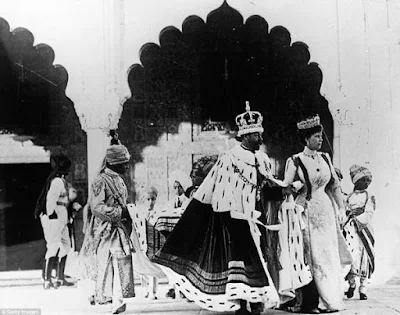This is a Short Pictorial depicting Life after 1857.
Five months after being coroneted alongside Queen Mary at Westminster Abbey on June 22, 1911, the royal couple travelled to India
King George V of Great Britain is pictured hunting a tiger during the 10-day expedition in Nepal in 1911 - following the Delhi Durbar in India
Former Gaekwar of Baroda, Maharajah Sayyaji Rao III, caused uproar at the ceremony when he gave one quick bow to the couple before turning and walking away laughing
This picture by an unknown Delhi artist might be seen as 'propaganda to gloss over past tensions between the Scindia dynasty and the British East India Company'. The Scindia (or Sindhia) dynasty, based from the late eighteenth century in Gwalior, ruled part of the larger Maratha confederation, Tate Britain said, pointing out that in 1818 the Scindias became clients of the British. The picture shows a British military officer - probably a light cavalryman - and naval colleague being entertained by a dance
Jai Singh Prabhakar, who was the Rahib Sahib of Ullwar (Alwar) from 1892 to 1937, was the only son of the region's previous ruler, Sir Mangal Singh Prabhakar Bahadur, and is shown here circa 1887 before he was crowned aged just 10
Begum Zenat Mahat, who was wife to the Bahadar Shah Zafar, was exiled to Rangoon after the Indian Rebellion of 1857
Colonel Brayzier, an Indian soldier shown here sitting sword-ready at the time of the 1857 Indian Rebellion, just before the British Raj, which ran from 1858 to 1947
This 1859 picture of the Taj Mahal in Agra as seen from the Jumna tributary of the Ganges
This is the devastation that was wrought by a mine, which exploded in the Chutter Munzil during the siege of Lucknow
The Khynabee Gate mosque in Delhi, photographed at the time of the Indian uprising against British colonial rule
These Sikh officers were part of the Hodson's Horse, a cavalry regiment of the Indian Army. This photo, shot before the British Raj in 1857, is also included in the display of pictures given to Queen Victoria.
These Sikh officers of Afghanistan served in the Hodson's Horse regiment of the British Army and are shown here during the Indian Rebellion of 1858
At odds: In contrast to his close relationship with George V, Nicholas II found Kaiser Wilhelm difficult
Five months after being coroneted alongside Queen Mary at Westminster Abbey on June 22, 1911, the royal couple travelled to India
King George V of Great Britain is pictured hunting a tiger during the 10-day expedition in Nepal in 1911 - following the Delhi Durbar in India
Former Gaekwar of Baroda, Maharajah Sayyaji Rao III, caused uproar at the ceremony when he gave one quick bow to the couple before turning and walking away laughing
This picture by an unknown Delhi artist might be seen as 'propaganda to gloss over past tensions between the Scindia dynasty and the British East India Company'. The Scindia (or Sindhia) dynasty, based from the late eighteenth century in Gwalior, ruled part of the larger Maratha confederation, Tate Britain said, pointing out that in 1818 the Scindias became clients of the British. The picture shows a British military officer - probably a light cavalryman - and naval colleague being entertained by a dance
Begum Zenat Mahat, who was wife to the Bahadar Shah Zafar, was exiled to Rangoon after the Indian Rebellion of 1857
Colonel Brayzier, an Indian soldier shown here sitting sword-ready at the time of the 1857 Indian Rebellion, just before the British Raj, which ran from 1858 to 1947
This 1859 picture of the Taj Mahal in Agra as seen from the Jumna tributary of the Ganges
This is the devastation that was wrought by a mine, which exploded in the Chutter Munzil during the siege of Lucknow
This 1858 shot shows the entrance to a temple in Dehli and is just one of the photos given to Queen Victoria in the hope of instilling insight into the daily lives of ordinary Indians
The Khynabee Gate mosque in Delhi, photographed at the time of the Indian uprising against British colonial rule
These Sikh officers were part of the Hodson's Horse, a cavalry regiment of the Indian Army. This photo, shot before the British Raj in 1857, is also included in the display of pictures given to Queen Victoria.
These Sikh officers of Afghanistan served in the Hodson's Horse regiment of the British Army and are shown here during the Indian Rebellion of 1858















No comments:
Post a Comment